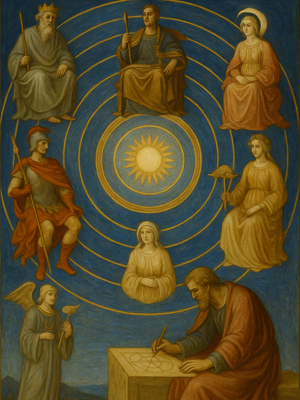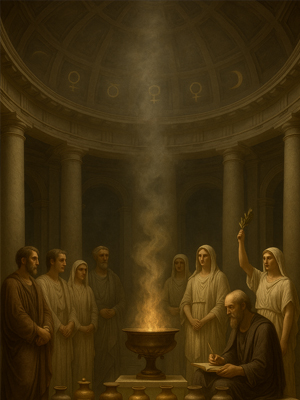Masonic Articles and Essays
The Secret Language of Smoke
Exc... Bro... Aksel Suvari 18°
Date Published:
10/21/2025
In the ages when smoke rose from altar and temple alike, incense was more than perfume, it was philosophy made visible. The ancients saw in its rising plume the soul’s own ascent, matter transfigured into spirit, a bridge between the mortal and the divine. Each resin bore the signature of a planet, each fragrance a note in the harmony of creation. To burn incense was to take part in the music of the cosmos itself.
Have we forgotten that even a breath of fragrance can still teach the soul to rise?
 In the metaphysical imagination of the Renaissance and the Middle Ages, incense was no trivial ornament of worship, but a sacrament of nature’s hidden sympathies. Its curling smoke was conceived as the visible body of an invisible speech, the exhalation of matter aspiring to the divine, and the response of the divine breathed back into the mortal world. The act of burning was thus no idle aesthetic, but a symbolic ladder between the elements: the solid becoming liquid, the liquid turned to air, and the air transformed into luminous fire. Through this ascending motion, the ancients discerned the procession of being itself, from body to soul to intellect.
In the metaphysical imagination of the Renaissance and the Middle Ages, incense was no trivial ornament of worship, but a sacrament of nature’s hidden sympathies. Its curling smoke was conceived as the visible body of an invisible speech, the exhalation of matter aspiring to the divine, and the response of the divine breathed back into the mortal world. The act of burning was thus no idle aesthetic, but a symbolic ladder between the elements: the solid becoming liquid, the liquid turned to air, and the air transformed into luminous fire. Through this ascending motion, the ancients discerned the procession of being itself, from body to soul to intellect.
The doctrine behind such practice is neither poetic whim nor superstition, but a rigorous natural philosophy. The cosmos, they held, is an ordered organism wherein every part reflects the whole. The stars are not remote ornaments but intelligible causes, whose powers descend through the intermediate planes of spirit and nature until they rest in the textures of plants, metals, and stones. Thus, every substance bears the signature of its celestial governor: the bitter resins of myrrh echo the austere temperament of Saturn; the sweet balsams of storax and benzoin exhale the benign warmth of Jupiter; the acrid gums of bdellium and asafoetida burn with the wrathful heat of Mars; and the radiant frankincense of Arabia, rising in pure flame, manifests the clarifying virtue of the Sun.
This correspondence between heaven and earth was understood as a system of resonance. To employ a planetary substance was not to flatter a god with gifts, but to awaken in oneself that quality which the star represented in the greater cosmos. The magician or priest was not so much conjuring an external spirit as invoking the analogical harmony between his microcosmic nature and the macrocosmic pattern from which it derived. The smoke rising from the censer was therefore a sacrament of the doctrine of analogy, the belief that the world is bound together by secret likenesses, that the same essence of order pervades stone and soul alike, and that through sympathy one may ascend from the visible to the invisible.
Among the ancient theurgists of Greece this principle became the very heart of divine invocation. The gods, said they, are intelligible lights too pure for direct apprehension by mortal thought. To approach them, man must work through intermediaries, forms, symbols, odours, and motions, that mirror their celestial qualities. The theurgic rites therefore employed material tokens not as bribes, but as mirrors. When the appropriate incense was kindled beneath the right constellation, the theurgist’s soul, harmonized through likeness, rose with the smoke to the order it imitated. The fragrance was not for the deity but for the human participant; it was the air in which the intellect could breathe the divine.
In this vision the cosmos itself is a liturgy. Each planet governs a hierarchy of materials whose very natures are hymns in matter. Saturn speaks through the dense, solemn odours of myrrh and cypress, meditating upon limitation, age, and the gravity of necessity. Jupiter resounds through the generous warmth of benzoin, nutmeg, and storax, bearing the benign fragrance of order and magnanimity. Mars kindles the acrid fires of bdellium, sulphur, and biting roots, purging corruption and sharpening will. The Sun, king of harmonies, delights in frankincense and ladanum, bright and dignified, which cleanse the air and reveal the form of truth. Venus whispers in amber, musk, rose, and red sandalwood, blending sweetness with magnetism and reconciling all discord. Mercury, ever mutable, flits through lavender and cinnamon, bringing quickness, wit, and the breath of articulate mind. The Moon, mistress of reflections, is pleased by camphor and white sandalwood, whose cool vapours clarify the imagination and open the gate of dreams.
To burn incense was therefore to participate in the cosmic harmony, to re-enact in miniature the eternal circulation of life and form. The operation was moral and metaphysical, not mechanical. For the resins were chosen not merely by scent but by temperament, their warmth, coldness, moisture, and dryness echoing the humoral balance of the planetary host. Through them, the priest sought to temper the inner constitution of his soul, to bring it into proportion with the order of heaven. Thus fumigation was a work of purification in the literal sense: it made the air, the very medium of life, consonant with the idea of the Good.
The Renaissance magi inherited this worldview from the Greeks and Arabs and gave it fresh theological colour. To them, incense was a sign of man’s mediating office between nature and spirit. The material world, fallen and divided, must be redeemed through conscious participation in its divine archetype. By understanding the sympathies of things and using them in reverence, man restored the broken bond between Earth and Heaven. The censer was the altar of this reconciliation. Its flame consumed the lower forms and liberated their subtle essence, as the intellect consumes the passions and frees the mind to contemplate the divine.
 In this sense, incense is an image of the soul’s own transmutation. The heavy gum, inert in its vessel, must first be placed upon the living coal, the ordeal of heat, before it yields its hidden fragrance. So too the soul, bound in material nature, must endure the purifying fire of discipline before its true nature ascends as a pleasing odour to the gods. The smoke’s gradual vanishing is not destruction but liberation; it signifies the ascent of form to spirit. The censer becomes a cosmological allegory: Earth transformed by Fire into Air, Air sublimed into Light, Light returning to the uncreated source.
In this sense, incense is an image of the soul’s own transmutation. The heavy gum, inert in its vessel, must first be placed upon the living coal, the ordeal of heat, before it yields its hidden fragrance. So too the soul, bound in material nature, must endure the purifying fire of discipline before its true nature ascends as a pleasing odour to the gods. The smoke’s gradual vanishing is not destruction but liberation; it signifies the ascent of form to spirit. The censer becomes a cosmological allegory: Earth transformed by Fire into Air, Air sublimed into Light, Light returning to the uncreated source.
This doctrine reveals an ethical implication often lost in later ages. The true purpose of sacred art, including fumigation, was never to compel external spirits but to order the internal man. The wise magus does not command the heavens; he harmonizes with them. He studies the natures of things so that his own nature may be conformed to their intelligible pattern. Incense, rightly used, disciplines the senses to perceive the spiritual correspondences hidden in matter, teaching the operator to see through the veil of smoke to the divine fire beneath.
Even the diversity of the planetary incenses mirrors the diversity of the human faculties. The saturnine odours awaken memory and contemplation; the jovial expand the heart in generosity; the martial strengthen courage; the solar illuminate reason; the venusian soften and harmonize the affections; the mercurial quicken thought and speech; the lunar refine the imagination. Together they compose a complete music of the soul, each note essential to the harmony of the whole. To master them is to master oneself, to bring intellect, emotion, and action into concert with the order of the cosmos.
The later mystics recognized in this art a figure of divine procession itself. The One diffuses through the hierarchy of being as scent through air; all things participate in its goodness by receiving and transmitting its invisible essence. The world, said they, is a temple perpetually filled with fragrance, and every act of understanding is a kindling of the inner censer. To burn incense before the gods is therefore to imitate the universe’s own act of worship, to let one’s thought ascend as the world’s smoke ascends toward its first principle.
This conception, when stripped of superstition, remains philosophically profound. It affirms that the cosmos is intelligible, that matter is not alien to spirit but its expression, and that beauty and order are the language of being itself. The burning of incense is the dramatization of this metaphysic: an acknowledgment that the visible and the invisible are joined by sympathy, that the divine is not elsewhere but hidden in the fragrance of things.
The medieval theologians, even when wary of magical interpretation, preserved this insight within their liturgy. The thurible swung before the altar was a sign of prayer ascending to God, but also of the sanctification of sense, the recognition that the material can be a vessel of the immaterial. The same motion that delighted the philosopher served the priest, for both acknowledged a universe suffused with meaning.
Thus, behind the delicate ceremony of incense lies an entire philosophy of creation: that to breathe is to partake of the divine rhythm, that every odour has its celestial root, and that man, by understanding and reverence, can restore the unity of heaven and earth. To kindle the censer is to re-enact the world’s first morning, when the elements mingled in perfect balance and the breath of the divine moved upon the face of the waters.
In this light, the old lists of resins and gums are not curiosities but fragments of a metaphysical grammar. Each substance is a letter, each blend a phrase, each rising column of smoke a verse in the great hymn of nature. Through them the soul learns once more to speak the language of creation, the forgotten tongue in which stars and stones, gods and men, converse.
More Masonic Articles
Explore articles and essays written by Freemasons about Freemasonry.
Read More
Membership
Interested in becoming a member of the worlds oldest Fraternal organization?
Read More